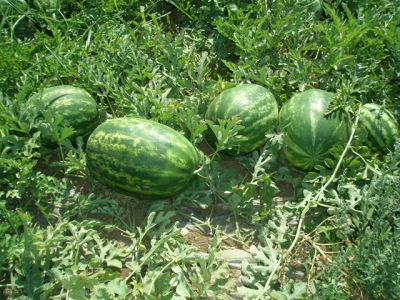An early start to the watermelon season

Watermelons command a higher price earlier in the season. Because of this, you might want to choose a variety that’s ready sooner, even if it’s lower-yielding.
Seeds on moist newspaper placed on plastic and an electric blanket. This will keep the seed warm and just moist enough for good germination.
The higher price may more than compensate for this drawback. It’s a balancing act. One way of tackling the job is to build ‘mini field hothouses’. A Bloemfontein farmer and I collaborated on doing this several years ago as an experiment. This is a cold area subject to late frosts, so it was no small challenge. We dug holes 20cm x 20cm and 12cm deep, added fertiliser to the soil and irrigated while the seed was being pre-germinated.
When the roots were just starting to protrude from the seeds, we planted two seeds in the moist soil in the hole. We then cut clear plastic sheeting to a suitable size and placed it over each hole, with some soil spaded onto the edges to hold it in place. Finally, we used a nail to make a small hole in the middle of each covering so that rainwater would flow through it into the cavity below, rather than accumulating on top and causing it to collapse.
This was done in late July, so there was still plenty frost to come. The soil in the hole was heated by the sun, as would happen in any hothouse. The plastic cover trapped the heat and ensured that the soil temperature stayed above dangerous levels. We had had one minor glitch: we failed to take into account that this microclimate would also stimulate weed growth. As a result, we had to lift the plastic, weed and re-cover the holes.
To stop weeds taking root, the following refinement is recommended: place a square of black or white plastic on the soil at the base of the hole, and make two tiny holes through which the seed can be planted in the soil.
Ideal conditions
By the time the leaves started pushing against the plastic cover, the weather was frost-free. It was at this stage that the vines began growing rapidly. As a result, the farmer was able to get his crop in early – and earn a price that more than justified the exercise.
Regardless of your location, it will benefit you to pre-germinate seeds. This will not only give you an earlier start but, in many cases, lead to better germination, as you are providing ideal conditions for the growing seeds. This is especially the case with triploid or seedless watermelons, which are inherently difficult to germinate. Given the high cost of seed, it makes sense to ensure as high a percentage of germination as possible.
A nifty trick
Watermelon seed prefers moist, but not overly wet, germination conditions. A handy way of controlling moisture level is to use newspaper and an electric blanket. Wet the newspaper, sprinkle the seeds on one half, and fold the other half of the paper over the seeds. Then fold a sheet of plastic over the newspaper.
Place this ‘package’ on an electric blanket. You will need to play with the settings to maintain a temperature of between 25°C and 30°C. It can go up to 35°C, but be careful not to exceed this.Start irrigating the land at the same time as you place the seeds in the newspaper. This will ensure it is moist enough to work with when the seeds are ready.
Germination
The seeds should begin to germinate in three to five days. As the root starts to protrude from the seed, plant it about 2cm deep in the damp soil. The root will penetrate the damp soil within a day. At the same time, the loose, moist soil above will act as a mulch by conserving moisture below and allowing the seedling to push through with no effort. Because of the moisture in the soil, it might be unnecessary to irrigate for quite some time after planting.
Related news
Tools

Phối trộn thức ăn chăn nuôi

Pha dung dịch thủy canh

Định mức cho tôm ăn

Phối trộn phân bón NPK

Xác định tỷ lệ tôm sống

Chuyển đổi đơn vị phân bón

Xác định công suất sục khí

Chuyển đổi đơn vị tôm

Tính diện tích nhà kính

Tính thể tích ao



 Give your watermelons the correct nutrient mix
Give your watermelons the correct nutrient mix  Growing watermelons – part 1
Growing watermelons – part 1